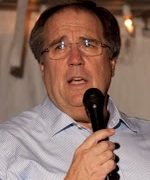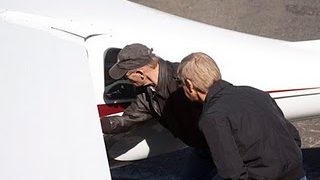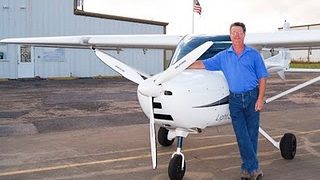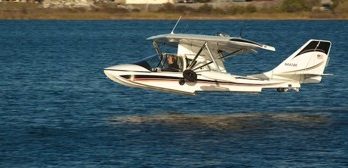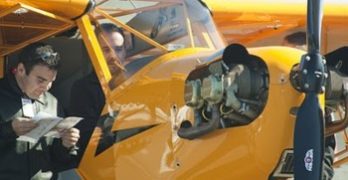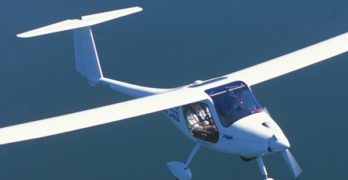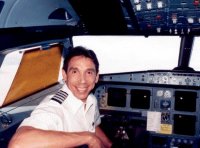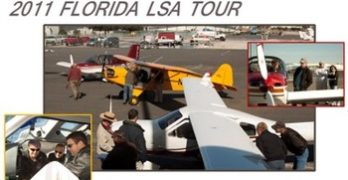In its declaration of 2011 as the year to “Rally GA”, AOPA echoes the call to action of its President, Craig Fuller, who said recently, “We don’t just want to watch for a turnaround (in General Aviation), we want to do everything we can to make it happen!” *** He’s urging members from all sectors of flight to honor, protect and promote our common treasure: – the freedom to fly. *** To do its part, AOPA put together a list of events for the coming year, places where we can all join in the celebration of flight and the discussion of how to move it forward. *** Check it out to see what’s coming your way.
Search Results for : MG 21
Not finding exactly what you expected? Try our advanced search option.
Select a manufacturer to go straight to all our content about that manufacturer.
Select an aircraft model to go straight to all our content about that model.
“Preflight? You Don’t Need No Stinkin’ Preflight!”
As I preflighted a rental J3 Cub last fall, an older gent, kind of scruffy looking, was keeping me company, though we’d never met. *** A pilot and airport regular, he quickly revealed his belief about preflighting in general. “Aw,” he said, rubbing his grizzled chin, “just go. It’s a Cub, it’s fine, just get in it and takeoff.” I looked at him, wondering if he was kidding. He wasn’t. *** “Well, thanks… I think…,” I replied, mildly annoyed, “but I think I’ll just finish up here if you don’t mind.” *** “Naw,” he said, waving at the air, “just jump in and go; it’s alright.” *** I ignored him and his distracting insistence, wondering what his game was. *** We didn’t know each other. He had no reason, or right for that matter, to try and persuade me to skip a vital part of good airmanship practice. Perhaps, I thought, he’s an angel sent to cement my determination to do things right.
Remos: New Dealer & Boy Scout Pow-Wow
Remos continues to build its U.S. sales/service network. The company just “promoted” Tom Pekar’s Success Aviation, near Houston, from a Pilot Center to it’s 16th Aircraft Dealer in the U.S. *** The new dealer has two Remos GX demos, one with an autopilot. Both are used in the school. *** “Most flight training operations involving the GX use about 3.2 gallons of fuel,” he says, “compared to over 5 in a Cessna 152 and close to 9 in a Skyhawk.” *** With the price of avgas jumping up the way it has been of late, flight schools nationwide have to at least be giving renewed thought to adding LSA trainers to their fleets. *** One of the tangible bonuses the GX brings to its quality build and superb handling characteristics (my personal view: it’s as sweet to fly as any LSA out there) is its capability of flying with the doors off.
Hot Off The Water
To the answer “Progressive Aerodyne!” comes the Jeopardy question, “What LSA company thumbs its nose at the bad economy?” *** Certainly one of the most-fun LSA flights I’ve had in some time came at the controls of that company’s SeaRey amphibian.My LSA pal Dan Johnson recently wrote up a piece on the amphib which spurred me to excerpt some highlights in advance of my own flight report on the lively sea bird coming soon in Plane & Pilot magazine. *** Wayne and Kerry Richter, second and third generation founders of Progressive Aerodyne, started back in the ‘70s with many memorable UL birds they created with dad/grandfather Stanley Richter. The company then was Advanced Aviation and it put out, among other craft, several iterations of a very popular ultralight amphib: the Buccaneer.Building on that success, as Dan notes, Progressive Aerodyne popped out 31 Experimental Amateur Built kits in 2010.
Aero and e-Flight Expo… coming soon
Right after Sun ‘n Fun, the e-flight Expo kicks off for the third time at “Aero” in Friedrichshafen, Germany, April 13-April 16. *** Bunches of new aircraft and propulsion technologies along with the awarding of the Lindbergh Electric Aircraft Prize (LEAP) will mark the gathering of 550 exhibitors from 26 countries. *** The e-flight name stands for more than electrical flight innovations: ecological and evolutionary advances in flight regardless of their nature are embraced, although electric is certainly leading the show. *** Erik Lindbergh, grandson of Charles Lindbergh, will present his foundation’s prize for outstanding achievements in the development of electric flight. *** This year should bring several exciting advances in electric flight . I’ll be doing a broad story for Plane & Pilot magazine soon on what’s up and what’s coming. *** Another highlight of the Expo is “History for the Future of Flight”, a tantalizing assemblage of descendants and close relatives of last century’s aviation pioneers: Claude Dornier, Igor Sikorsky, Marcel Dassault and Count Zeppelin.
AOPA to FAA: Let CFI-S Hours Count for the Private License!
There’s been some controversy lately regarding FAA’s mandate that flight training towards the Sport Pilot license is not allowed to count toward the Private Pilot (PPL) and higher licenses and ratings unless the instructor is a certificated CFI, rather than a CFI-S (as FAA delineates Sport Pilot-only instructors). *** Recently, AOPA petitioned the FAA to change the regulations and allow those hours to count for all higher levels of certificated airmanship. *** The pilot member organization picked up support along the way from EAA, GAMA (General Aviation Manufacturers Association), and NAFI (National Association of Flight Instructors), all of which are now petitioning FAA to change these regs: FAR Part 61.99 and 61.109. The specific language asks FAA to “permit the instruction time received in pursuit of a sport pilot certificate to be credited toward the instruction requirements of additional certificates and ratings.” *** Of course, getting advanced ratings requires training from a qualified CFI.
Flying Cessna’s LSA Skycatcher
Honestly, I never thought I’d see this day arrive. As I started work
on a Cessna aircraft review for the pages of Light Sport and
Ultralight Flying magazine, I thought, We’ve come a long way.
When this publication was started 35 years ago, it was titled Glider Rider
and it featured hang gliders. Coverage then expanded to include powered
ultralights, and now light-sport aircraft (LSA) are included in the mix.
This month I’ve written a pilot report on Cessna Aircraft’s Skycatcher
LSA, the first Cessna in modern memory not built to FAR Part 23 standards,
that is, not type-certified by the U.S. government. Some may say ultralights
“grew up” to become light-sports. But I say that Cessna has moved
(returned?) to very light aircraft designs. I consider their arrival significant.
It isn’t simply that you can buy a brand-new Cessna for $112,500 (more on
the price later). The more important point to Light Sport and Ultralight
Flying readers is that the Skycatcher flies similarly to what light aircraft
enthusiasts fly.
Sleek, Comfortable and Fun; The Sinus Motorglider
Many Americans will agree
the name of this aircraft is odd, and that may be a kind word for the common reaction to “Sinus.” Is the name that important? Sinus (pronounced Seen-us), the aircraft, is a sleek, slender machine capable of impressive performance.
Any soaring-attuned pilot can easily live with the name Sinus for the 49-foot span and, get this, 28-to-1 glide performance! On first glance, except for its elegant, shapely, and thin wings, the Sinus looks like a proper light sport airplane. Pilot Matevz Lenarcic flew one around the world solo, in 80 days, and with zero ground or air support (see “Microlight Motorglider Flies Around the World,” April ’05 UltralightFlying! magazine).
What’s In a Name After All?
Let’s consider that name. U.S. dealer Robert Mudd says Pipistrel – the manufacturer – prefers to pronounce it “seen-us,” not “sighn-us.” They say this refers to a perfect sound wave or sine wave rather than a head cold.
Larry Newman, 2011
Larry Newman, 63, one of the seminal manufacturing/marketing dynamos in the early days of hang gliding who made the successful transition to ultralights, has died after a reported 3-year battle with pancreatic cancer. *** Larry was a flamboyant entrepreneur who successfully sold his ElectraFlyer hang gliders. *** When people started sticking motors on the foot launched craft, he came out with a new company, American Aerolites, to produce the Eagle ultralight. *** I first flew the Eagle with Plane & Pilot Publisher Steve Werner back in 1983. I remember it vividly: while Steve was up on a test hop, I was taking photos of his flight next to the runway at Coronado Airport, north of Albuquerque, near Larry’s factory…and I got stung twice by fire ants.I almost jumped out of my jeans, it hurt so bad. I thought I’d been shot in the leg. I could barely see the critters but what a painful wallop they packed.
Sebring Wrap Up…and Beyond
I’d call this Day 4 but rush-deadline work for the mag intervened after the last day at Sebring so just getting to it now. *** The Sebring experience gets better every year, I believe precisely because Bob Woods keeps it consistently valuable without tricking it up with a lot of extraneous booths selling things like Miracle Kitchen Knife or iPhone WonderMuffin Pocket Baker and the like: it’s an LSAshow, pure and simple, and a great opportunity for folks to crawl out from wherever winter is tap-dancing on their heads and let them see, compare, fly and even buy aircraft and peripheral stuff.Many airframe makers reported sales at the show, or expected deals to close afterward. Exhibitors hope for sales of course, but realize folks often need to go home, reflect on what they’ve seen, then push the button or think more on it. *** I’d say from everybody I talked to, optimism was rekindled that 2011 will be better than the last — a real toughie.
- « Previous Page
- 1
- …
- 71
- 72
- 73
- 74
- 75
- …
- 94
- Next Page »


